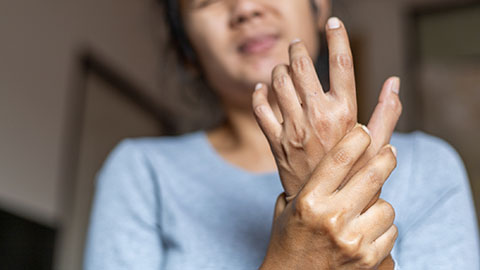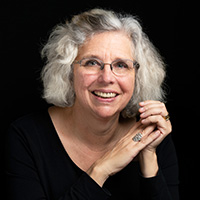04/30/2021

A client wants deep work in his hamstrings, but he has a couple of situations that might make it questionable: Parkinson’s disease and a recent onset of a new condition for him called pseudogout. What is pseudogout, how is it different from traditional gout, and what can this massage therapist do in this complex situation?
Recent Article by Ruth:
“Critical Thinking,” Massage & Bodywork magazine, May/June 2021, page 54, www.massageandbodyworkdigital.com/i/1358392-may-june-2021/56.
References:
Botero, Herman. “Pseudogout Causes.” Last modified October 28, 2020. www.arthritis-health.com/types/pseudogout-cppd/pseudogout-causes.
Robinson, Jennifer, ed. “Arthritis and Pseudogout.” June 9, 2020. www.webmd.com/arthritis/arthritis-pseudogout.
Rothschild, Bruce. “Gout and Pseudogout.” Last modified January 26, 2021. https://emedicine.medscape.com/article/329958-overview.


This podcast sponsored by:
About Anatomy Trains:
Anatomy Trains is a global leader in online anatomy education and also provides in-classroom certification programs for structural integration in the US, Canada, Australia, Europe, Japan, and China, as well as fresh-tissue cadaver dissection labs and weekend courses. The work of Anatomy Trains originated with founder Tom Myers, who mapped the human body into 13 myofascial meridians in his original book, currently in its fourth edition and translated into 12 languages. The principles of Anatomy Trains are used by osteopaths, physical therapists, bodyworkers, massage therapists, personal trainers, yoga, Pilates, Gyrotonics, and other body-minded manual therapists and movement professionals. Anatomy Trains inspires these practitioners to work with holistic anatomy in treating system-wide patterns to provide improved client outcomes in terms of structure and function.
Website: anatomytrains.com
Email: info@anatomytrains.com
Facebook: facebook.com/AnatomyTrains
Instagram: instagram.com/anatomytrainsofficial
0:00:00.0 Speaker 1: Ruth Werner's best selling book, A Massage Therapist's Guide To Pathology is a highly regarded comprehensive resource that sets the standard for pathology education. Written for massage therapy students and practitioners, this groundbreaking resource serves up a comprehensive review of the pathophysiology, signs, symptoms, and treatment of more than 500 diseases and disorders. Learn more at booksofdiscovery.com.
0:00:32.3 Speaker 2: Anatomy Trains is happy to announce our return to the dissection lab in person, January 10th to the 14th, 2022 at the Laboratory of Anatomical Enlightenment in Boulder, Colorado. We are thrilled to be back in the lab with Anatomy Trains author Tom Meyers, and master dissector, Todd Garcia. Joins students from around the world and from all types of manual, movement and fitness professions to explore the real human form, not the images you get from books. This is an exclusive invitation. Email info@anatomytrains.com, if you'd like to join us in the lab.
[music]
0:01:17.2 Ruth Werner: Hi, and welcome to I Have A Client Who, Pathology Conversations with Ruth Werner, the podcast where I will discuss your real-life stories about clients with conditions that are perplexing or confusing. I'm Ruth Werner, author of A Massage Therapist's Guide to Pathology, and I have spent decades studying, writing about, and teaching about where massage therapy intersects with diseases and conditions that might limit our client's health. We almost always have something good to offer, even with our most challenged clients, but we need to figure out a way to do that safely, effectively and within our scope of practice. And sometimes, as we have all learned, that is harder than it looks.
0:02:02.0 RW: Today's I Have A Client Who story, comes from a massage therapist in South Carolina who shares this. "Hi, Ruth. I Have A Client Who has Parkinson's disease and was recently hospitalized for newly diagnosed pseudogout. He requested massage, specifically hamstring stretching, and I'm hesitant because I know little about this pathology. Is a contraindicated? I just don't want to trigger a flare." Well, that's short and to the point. It's a perfect I Have A Client Who story. But I was unable to get any more information about this client from our contributor, so all we know is that the client is a man, he has Parkinson's disease, and he recently had an acute flare up of pseudogout, which was a new situation for him. Given this information, I think it's safe to guess that this client is probably mature since although Parkinson's and pseudogout can happen in younger people, these situations are pretty unusual in people under 60.
0:03:00.5 RW: This client feels tight and restricted in his hamstrings, and this is consistent with things that we see with Parkinson's disease. This movement disorder often leads to hypertonicity in flexors, which is why we sometimes see people with Parkinson's have stooped posture and a tight shuffling gait. But Parkinson's is not really the centerpiece of this question, so I will delay a discussion of Parkinson's until we get and I Have A Client Who story where it is the main feature. Please, will you send me a story where Parkinson's disease is the main feature. I love talking about Parkinson's. And you can do that at ihaveaclientwho@abmp.com, that's ihaveaclientwho, all one word, all lowercase @abmp.com. And of course, it doesn't just have to be stories about Parkinson's, it can be stories about any interesting pathologic situation that arises in your practice.
0:03:56.9 RW: But for today, let's turn our focus to pseudogout. Gout and pseudogout are both conditions in which substances in the blood precipitate out in interstitial spaces and form sharp crystals. And these sharp little shards of glass can gather in our extremities where the ambient temperature is a little cooler than it is in our core, and they can erode joint capsules from the inside and from the outside. Traditional gout is associated with high living, lots of alcohol and meat and seafood and high purine diets. Benjamin Franklin had it and Henry VIII and some other very fancy people. And someday, I will tell you about my own adventures with gout which was no fun at all. But pseudogout is associated with a different chemical process.
0:04:47.9 RW: Traditional gout is caused by the accumulation of monosodium urate monohydrate crystals. It is associated with uricemia, uric acid in the blood, and people who have it may also deal with kidney stones and some other urinary system issues. But pseudogout is caused by something else, calcium pyrophosphate crystals. And the nice people at ease medicine where I got this information suggest that pseudogout really should be called calcium pyrophosphate disease or CPPD. These crystals accumulate in the cartilage of our synovial joints, but if they shift into the joint spaces, then bad, bad things can happen.
0:05:30.5 RW: Now, if you know me at all, you may be aware that I don't do a lot of chemistry. So the exact chemical processes that bring traditional gout and pseudogout about, these are not my main focus, but it matters a lot in terms of getting an accurate diagnosis and effective treatment. Pseudogout won't respond to the basic treatment regimen for traditional gout and vice versa. And these conditions are both very painful, ask me how I know, and also treatable, so we wanna be sure that the right treatment gets started as early as possible.
0:06:09.1 RW: We usually see traditional gout at the base of the great toe. But pseudogout is more often seen at larger joints like the knee or the wrist. As I mentioned, it has to do with the abnormal formation of calcium pyrophosphate crystals in the joint cartilage. When those crystals are released into the synovial fluid, we get a huge and extremely painful inflammatory reaction. But here's the deal, unlike traditional gout, the accumulation of those calcium pyrophosphate crystals, this is not connected to diet, or sex or any other lifestyle factors. It is more common in older people, so age is one issue, and there may be some genetic predispositions as well, and sometimes it is related to some other cartilage problems. And if the crystals are already found in cartilage, then any sudden illness or surgery or joint injury can release them into the joint space causing a flare up. And when that happens, the affected joint is painful, and this usually develops over days rather than hours, which is more typical of traditional gout. The joint is swollen, discoloured, hot, and even the slightest touch is painful.
0:07:27.5 RW: Pseudogout is almost always at just one location, but if it is untreated, it may progress to affect multiple joints. Most people with Pseudogout are over age 60. Men and women get it in similar numbers. It's sometimes connected to some relatively rare issues like hyperparathyroidism or hemochromatosis, which is a problem in how we use iron in red blood cells or some other things. It also has crossover with osteoarthritis and regular gout just to make things more interesting. The only way to get an accurate diagnosis is by aspirating some fluid, this is called arthrocentesis, from an effective joint and analysing its chemical makeup. But here's the tricky part, it's possible to have traces of calcium pyrophosphate without having pseudogout, so even a joint aspiration is not always completely conclusive.
0:08:23.1 RW: Pseudogout is treated with nonsteroidal anti-inflammatories, especially ibuprofen and naproxen, and these can usually help to resolve symptoms quickly. Steroidal anti-inflammatories might be used if the person can't tolerate the NSAIDs. And colchicine, this is a drug derived from crocuses that is also used with traditional gout. This is sometimes used in long term, low doses to help prevent future episodes.
0:08:49.5 RW: So what does this mean for massage therapists in general and for our contributor in particular? Well, as always, it depends. The first thing I'd like to know about this client is where his attack of pseudogout took place. If it was at a knee where he feels his hamstrings are really tight and constricted, that's an important piece of information. Another concerning issue is this client's hospitalization. I did a quick search to find out if people are typically hospitalized with calcium pyrophosphate disease, and this does not seem to be the case, but gout and pseudogout as complications often happen among hospitalized patients, and this could be related to stress and dehydration and trauma from surgery and other hospital based challenges. So this client seems to have had kind of an unusual experience, if his joint pain lead to a hospital stay rather than a hospital stay leading to his joint pain.
0:09:45.8 RW: So once again, here's the information we have. This client has both Parkinson's disease and a new onset of pseudogout that is severe enough to require hospitalization. He'd like to receive massage focused on his hamstrings. I'm gonna say that this sounds like specifically targeted massage is not a good idea yet. When he's recovered, and he's back to normal activities with no remaining joint pain or swelling at the affected joint, especially if it's a knee, then massage could be great. It might not permanently undo some of the motor issues seen with Parkinson's, but it probably won't make anything worse.
0:10:22.0 RW: The contributor says he's concerned about triggering a flare. And that's a great concern. And I'm glad he's thinking about it. However, I do want to point out that it's unlikely that standard types of massage could disrupt cartilage enough to trigger a pseudogout flare, and standard types of massage are not going to spread gout from one joint to another. If he's doing super intrusive work around joint capsules, or stretching and mobilising joints in some very extreme way, that would be a different kind of caution.
0:10:56.1 RW: So, I do want to say thanks to our contributor for sharing the story, and for their caution and concern about taking great care of this very unusual client. And if I hear anything else about this client that seems relevant for you to know, I will be sure to tell you.
0:11:13.3 RW: Hey, everybody, thanks for listening to I Have A Client Who, Pathology Conversations with Ruth Werner. Remember, you can send me your I Have a Client Who stories to ihaveaclientwho@abmp.com, that's ihaveaclientwho, all one word, all lowercase @abmp.com. I can't wait to see what you send me, and I'll see you next time.
0:12:32.0 Speaker 1: Members are loving ABMP Five-Minute Muscles and the ABMP Pocket Pathology, two quick reference web apps included with ABMP membership. ABMP Five-Minute Muscles delivers muscle-specific palpation and technique videos plus origins, insertions, and actions for the 83 muscles most commonly addressed by bodyworkers. ABMP Pocket Pathology created in conjunction with Ruth Werner, puts key information for nearly 200 common pathologies at your fingertips and provides the knowledge you need to help you make informed treatment decisions. Start learning today. ABMP members log in at abmp.com and look for the links in the featured benefits section of your Member home page. Not a member? Learn about these exciting member benefits at abmp.com/more.





